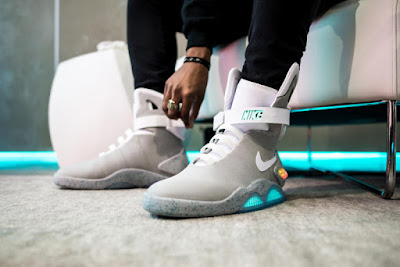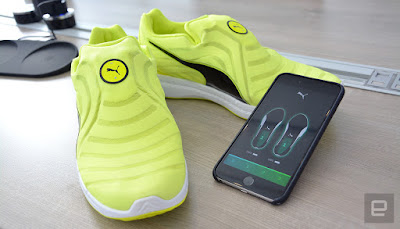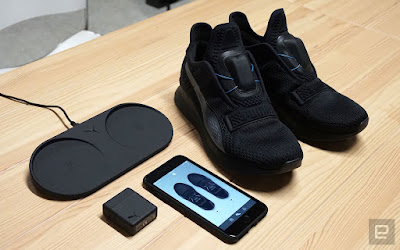The buzz for self-lacing sneakers reached a new high after the 1989 film, Back to the Future II. The main character, Marty picked up a pair of self-lacing sneakers after he made a time jump to 2015.
In April 2009, Nike filed a patent for self-lacing sneakers with a similar design, called the Nike MAG. In 2015[ ikr], the shoe was unveiled and scheduled to go on sale March 20,2016.
 |
| Nike MAG - 2016 |
Only 89 pairs were made available to the public through a raffle. You could probably cop a pair on eBay if you have $20-$30k lying around. They are rechargeable and tighten up whenever your heels touch the insole. There are also buttons on the side to enable you to adjust the fit. However, these are not meant for sports and can't be worn as casual sneakers.
In response to that reality, Nike followed up with the HyperAdapt 1.0 in September, 2017. An automatic self-lacing sneaker with two buttons to adjust or loosen the fit. It provides two weeks of battery life on 3 hours of charge.
 |
| Nike HyperAdapt 1.0 |
On the other side, market competitor, Puma was also working on their interpretation of the concept. In November 2015 they released 50 pairs of Autodiscs with many of them reserved for athletes like Usain Bolt. It featured built-in motors that can be manipulated with a push on the shoes or in the accompanying mobile app.
 |
| Puma Autodiscs - @Engadget |
In December 2018 Nike was gearing up to announce its first self-lacing basketball shoe. In February, the auto-lacing, app-controlled Nike Adapt BBs were released for retail. These contain a power-lacing system called FitAdapt that automatically adjusts the lacing system to fit perfectly around your foot once they're in. The fit can also be adjusted manually or with a mobile app. The app also provides extra options like changing the colour of the LED lights, saving your adaptive fit and checking battery life.
Nike says the sneakers can last up to 14 days on 3 hours of charge. The Adapt BBs are currently being retailed for $350 which is much easier to swallow than the $750 price tag of theHyperAdapt 1.0s.
 |
| Nike Adapt BB |
They also have a Mag-like colourway called the Nike Adapt BB "Mag".
 |
| Nike Adapt BB "Mag" |
The Adapt BBs are performance basketball shoes and as such can feel cumbersome at times. This prompted Nike to release a more casual self-lacing shoe in September. Enter the Nike Adapt Huarache, a reimagined version of a classic 1991 sneaker. These feature all the tech on the Adapt BB at the same price.
 |
| Nike Adapt Huarache |
After the Autodiscs, Puma spent 3 years developing a new self-lacing shoe which is due for release spring next year at $ 330. They are called the Puma Fi (Fit Intelligence).
 |
| Puma Fi - @Engadget |
Puma's sneaker still relies on a top-side custom cordless moto that can be manipulated by swiping the module or using the companion smartphone app. According to Puma, each shoe weighs 425 grams, with 11% consisting of electronic and mechanical parts. With 90 to 120 minutes of charge, the Fi is expected to last 5 to 7 days which is nowhere near the Adapt's. Customers can try on the sneakers through Puma's open beta program whiles providing the company with useful feedback and ideas.
Self-lacing sneakers provide numerous advantages like comfortability, time conservation and enabling disabled people to easily tie their shoes. In spite of all these, they come with a pretty hefty price tag. I sure hope they would reduce sometime in the future.


